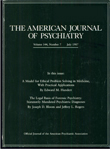Stella Chess, M.D.
Born in 1914 in New York City, the middle of three children of parents who had emigrated from Russia, Stella Chess attended the Ethical Culture School in New York and Smith College and entered New York University College of Medicine in 1935. In her third year at medical school, she met and worked with Lauretta Bender. The experience was like an awakening; Chess knew at once that she was going to be a child psychiatrist. She completed a residency in psychiatry at Grasslands Hospital in Eastview, N.Y., and enrolled in psychoanalytic training. In 1964 she joined the faculty of New York University in Bellevue Hospital Medical Center, thus becoming part of the New York University-Bellevue tradition of a continuous line of distinguished women child psychiatrists (Lauretta Bender, Stella Chess, Barbara Fish, Magda Campbell, Dorothy Otnow Lewis).
Stella Chess's scientific contributions are of major importance. The New York Longitudinal Study, started in 1956 and still going strong, is her tour de force. Chess not only recognized in a detailed and carefully observed way that children had individual styles of behavior, she also discovered a clinical method of interviewing the parents that provided accurate descriptions of these special characteristics of the child. The scientific research problem of organizing the data was solved by Herbert Birch and his co-worker Margaret Hertzig, who together identified nine separate qualities, or traits, that constituted what came to be called the temperament of the child. Birch also developed the quantitative rating system used for each temperament trait. Chess discovered three broad categories of temperament—“the easy child,” “the difficult child,” and “the slow-to-warm-up child.” The first publication appeared in 1957 (1). More articles quickly followed, and in 1960 the true heart of the matter was revealed in an important paper by Chess, Thomas, Birch, and Hertzig called “Implications of a Longitudinal Study of Child Development for Child Psychiatry” (2). The concepts and the research were quickly picked up in many parts of the world, including England, where Michael Rutter in 1963 first used the term “temperament” and considered its genetic aspects.
Stella's concepts of temperament and goodness or poorness of fit offered a paradigm shift for understanding the child's behavior—from a prevailing psychoanalytic model of a basic intrapsychic conflict and anxiety in the child to a new model in which the child's intrinsic patterns of behavior came first, followed by parental goodness or poorness of fit. Any parental mismatch and disapproval that might emerge might then generate anxiety and subsequently give rise to behavioral symptoms in the child, especially when the parent's anger mounted. Nowadays, the goodness of fit transactional model is one of the basic models used in a broad spectrum of child mental health services, ranging from children's psychiatric inpatient services to pediatric practice and work in schools.
Stella has also made many other contributions. In 1971 she hypothesized a relationship between some cases of congenital rubella and autism, raising the possibility of a neurological basis for autism. She also started one of the earliest, if not the first, psychiatric-pediatric liaison clinics within a pediatric service. She also founded, in 1968, the highly successful series of volumes called Annual Progress in Child Psychiatry and Child Development, an annual text that continues to be published.
Address reprint requests to Dr. Lewis, Yale Child Study Center, Yale University School of Medicine, 333 Cedar St., New Haven, CT 06510.
1 Thomas A, Chess S: An approach to the study of sources of individual difference in child behavior. J Clin Exp Psychopathol 1957; 18:347–357Medline, Google Scholar
2 Chess S, Thomas A, Birch HG, Hertzig M: Implications of a longitudinal study of child development for child psychiatry. Am J Psychiatry 1960; 117:434–441Link, Google Scholar



